| The Top Five Morbid Amphibians |
If you thought the Amphibia were all magic kisses and songs about the
Caribbean...well, you're pretty much right. It's a scientific fact that all good people
are delighted by frogs. Some amphibians, however, may be more or less delightful
depending on your taste, and here I shall be summarizing, for your enjoyment, the
five amphibians that would appeal more to the likes of David Cronenberg than Jim
Henson...
Caribbean...well, you're pretty much right. It's a scientific fact that all good people
are delighted by frogs. Some amphibians, however, may be more or less delightful
depending on your taste, and here I shall be summarizing, for your enjoyment, the
five amphibians that would appeal more to the likes of David Cronenberg than Jim
Henson...
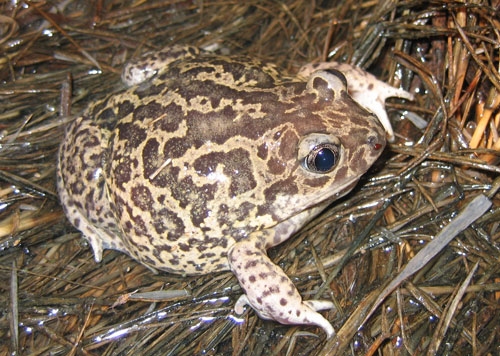
So named for the broad, hardened hind feet, these roly-poly cuties inhabit desert
environments where bodies of water may only last weeks at a time. Burying
themselves deep in the earth, they await the rainy season to mate, lay eggs, and
return to their subterranean slumber.
environments where bodies of water may only last weeks at a time. Burying
themselves deep in the earth, they await the rainy season to mate, lay eggs, and
return to their subterranean slumber.
| THE AMPHIBIAN: |
| #5 - The Spade-foot Toad |
| #4 - The Spiny Newt |
| THE HORROR: |
Amphibians need water to rear their larvae, and when water is such an ephemeral
commodity, strange adaptations can arise. Unlike the strictly herbivorous tadpoles
of most other species, young spadefoots may scavenge off dead animals or even
prey on small invertebrates, and when vegetation is scarce or their environment
begins to shrink, a certain portion of the population will convert to full
carnivorousness. The weaker, omnivorous individuals become as cattle to their
own flesh-eating siblings, who grow at an accelerated rate on their new diet,
ensuring they reach maturity before they're left high and dry.
commodity, strange adaptations can arise. Unlike the strictly herbivorous tadpoles
of most other species, young spadefoots may scavenge off dead animals or even
prey on small invertebrates, and when vegetation is scarce or their environment
begins to shrink, a certain portion of the population will convert to full
carnivorousness. The weaker, omnivorous individuals become as cattle to their
own flesh-eating siblings, who grow at an accelerated rate on their new diet,
ensuring they reach maturity before they're left high and dry.

Limited to an extremely small area, this critically endangered salamander (yes,
newt and salamander are interchangeable terms - and genetically speaking, so is
frog and toad) spends its adult life on land and five months of the year in
hibernation. Rather than enter water to breed, it leaves its eggs on the ground to
be washed into ponds by rain.
newt and salamander are interchangeable terms - and genetically speaking, so is
frog and toad) spends its adult life on land and five months of the year in
hibernation. Rather than enter water to breed, it leaves its eggs on the ground to
be washed into ponds by rain.
| THE AMPHIBIAN: |
| THE HORROR: |
When this newt finds itself in the clutches of a predator, it flexes its body, driving its
needle-sharp rib bones out through its sides. Along the way, each rib penetrates a
tiny sac of poison, delivering a series of painful stings to unprotected flesh.
Regrettably, nobody appears to have taken a photograph of this.
needle-sharp rib bones out through its sides. Along the way, each rib penetrates a
tiny sac of poison, delivering a series of painful stings to unprotected flesh.
Regrettably, nobody appears to have taken a photograph of this.
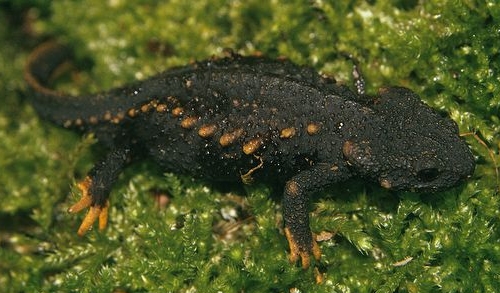
| #3 - African Hairy Frog |
Mundane at first glance, males of this species develop their famous "hair" during
mating season, actually an outgrowth of the skin that helps to absorb oxygen. This
allows the males to spend an extended period of time submerged in water (even
by frog standards) and closely guard their eggs after the female moves on.
mating season, actually an outgrowth of the skin that helps to absorb oxygen. This
allows the males to spend an extended period of time submerged in water (even
by frog standards) and closely guard their eggs after the female moves on.
| THE AMPHIBIAN: |
| THE HORROR: |
Like the spiny newt, the hairy frog has a self-mutilating hidden defense
mechanism, and though it lacks the toxic qualities, this one is, I think you'll agree,
slightly more cringe-worthy: by snapping apart the bones in its own fingers, it
produces sharp, hooked shards to slash at its attacker.
mechanism, and though it lacks the toxic qualities, this one is, I think you'll agree,
slightly more cringe-worthy: by snapping apart the bones in its own fingers, it
produces sharp, hooked shards to slash at its attacker.
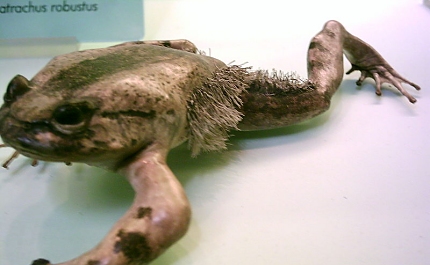
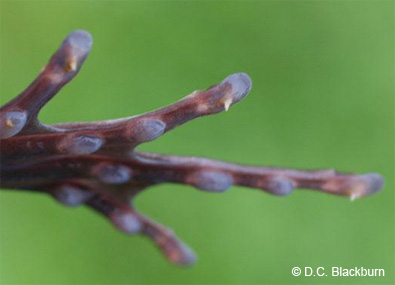
| #2 - Pipa Pipa |
Also known as Surinam toads and star-fingered toads, members of the Pipa
genus are completely aquatic, never voluntarily leaving the water and almost
helpless on land. Their mottled, leaf-like bodies make excellent camoflage against
a dirty riverbed, and their interesting star shaped fingertips act as sensitive feelers
to detect small prey animals.
genus are completely aquatic, never voluntarily leaving the water and almost
helpless on land. Their mottled, leaf-like bodies make excellent camoflage against
a dirty riverbed, and their interesting star shaped fingertips act as sensitive feelers
to detect small prey animals.
| THE AMPHIBIAN: |
| THE HORROR: |
During mating, the male and female Pipa swim around one another in an
underwater dance with a bizarre purpose; as the female releases her eggs, the
male presses them into her back, where they immediately stick. Over time, her
flesh will grow to almost completely entomb the eggs, leaving behind a sort of
"honeycomb" once they have hatched. The larva will remain in these tiny pockets
until fully developed into toadlets, and will even practice swimming in and out of
their mother's back as they prepare to move out on their own.
underwater dance with a bizarre purpose; as the female releases her eggs, the
male presses them into her back, where they immediately stick. Over time, her
flesh will grow to almost completely entomb the eggs, leaving behind a sort of
"honeycomb" once they have hatched. The larva will remain in these tiny pockets
until fully developed into toadlets, and will even practice swimming in and out of
their mother's back as they prepare to move out on their own.

| #1 - Caecilians |
These completely limbless, primarily subterranean animals are considered the
most mysterious amphibian order, seldom seen and poorly researched due to
their elusive lifestyle. Equipped with rows of needly teeth, they are thought to feed
primarily on earthworms and burrowing insects.
most mysterious amphibian order, seldom seen and poorly researched due to
their elusive lifestyle. Equipped with rows of needly teeth, they are thought to feed
primarily on earthworms and burrowing insects.
| THE AMPHIBIAN: |
| THE HORROR: |
In at least one species of Caecilian, Boulengerula taitanus, the female develops an
extra layer of nutrient-rich skin as she awaits her eggs to hatch. Stripping it away
with their fully-developed teeth, the young will subsist almost exclusively off their
mother's outer flesh, which fully regenerates every three days until her offspring are
large enough to fend for themselves.
extra layer of nutrient-rich skin as she awaits her eggs to hatch. Stripping it away
with their fully-developed teeth, the young will subsist almost exclusively off their
mother's outer flesh, which fully regenerates every three days until her offspring are
large enough to fend for themselves.
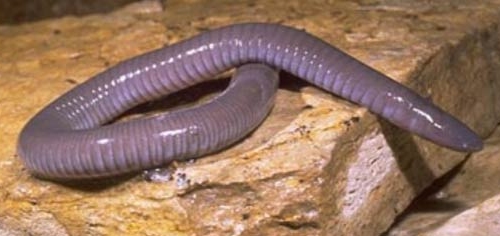
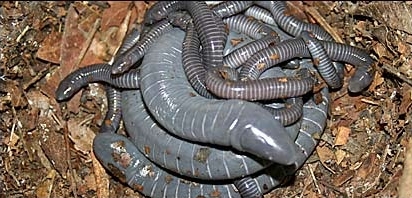
| Written by Jonathan C. Wojcik - Photo credits unknown or from public news outlets. |
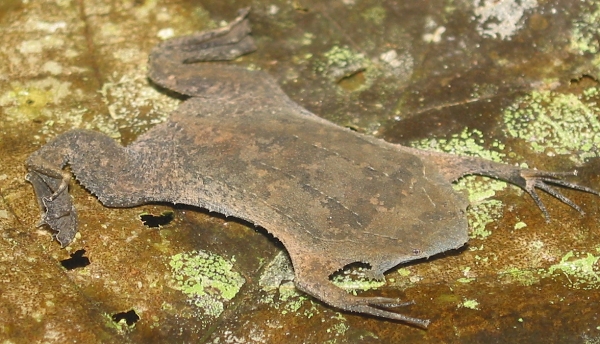
| photo by Helixblue |